Abstract
Fuel cell hybrid electric vehicles (FCEVs) have gained significant attention due to their environmentally friendly nature and competitive performance. These vehicles utilize a fuel cell system as the primary power source, with a secondary power source such as a battery pack or supercapacitor. An energy management strategy (EMS) for FCEVs is critical in optimizing power distribution among different energy sources, considering factors such as hydrogen consumption and efficiency. The proposed EMS presents an optimized external energy maximization strategy using the Harris Hawks Optimization to reduce hydrogen consumption and enhance the system’s efficiency. Through a comparative simulation using the Federal Test Procedure (FTP-75) for the city driving cycle, the performance of the proposed EMS was evaluated and compared to existing algorithms. The simulation results indicate that the proposed EMS outperforms other existing solutions in terms of fuel consumption reduction, with a potential reduction of 19.81%. Furthermore, the proposed energy management strategy also exhibited an increase in system efficiency of 0.09%. This improvement can contribute to reducing the reliance on fossil fuels and mitigating the negative environmental impacts associated with vehicle emissions.
1. Introduction
The need for energy has increased throughout the history of industrial evolution. There has been a massive rise in demand for fossil fuels throughout industrial development as reported in [1]. As industrialization grew, so did the energy needed for transportation, manufacturing, and other industrial processes. Coal, oil, and natural gas were all readily available, plentiful energy sources that were concentrated and dependable. They were essential for running automobiles, machines, and factories, which sped up economic progress [2,3]. The use of fossil fuels has become increasingly dependent on technological developments, particularly in infrastructure, transportation, and machinery. The transportation industry emits a considerable portion of greenhouse gases [4,5], and thus a lot of work is focused on replacing conventional engines with electric-powered vehicles [6,7]. These cars power an electric motor by combining an FC “fuel cell” [8,9,10] and an ESS “energy storage system” [11,12]. This technology improves fuel economy and saves energy [13]. FCEVs have various advantages, including high performance without emitting greenhouse gases, silent operation, compact size, and independence from fossil fuels [11,14]. The US Department of Energy (DOE) has set lofty goals for FCEVs to reach by 2025, including a target cost of $40/kW (for more than 5000 h), with even more aggressive targets of $30/kW net and 8000 h for performance and lifetime [15]. These goals are critical in developing a sustainable and ecologically friendly transportation sector.
Electric vehicles (EVs) are predicted to play an important part in future intelligent grids [16,17], helping to provide a secure and sustainable environment [18]. Because FCEV power systems are entirely electric, energy storage (such as supercapacitors or batteries) are critical in recovering or delivering power during braking or acceleration [19]. To solve operational problems and improve overall performance, integration with supercapacitors (SCs) with quick dynamics is required. This is especially essential given the slow dynamics of fuel cells as well as the constraints of battery charging and discharging cycles [20]. The operating conditions for the FC system are improved by hybridization, resulting in improved performance. An EMS “energy management strategy” is necessary for these hybrid multisource systems to reduce hydrogen consumption, manage power flow, and increase efficiency [21]. However, the efficacy of the chosen EMS approach or control mechanism is critical in delivering the desired results.
The EMS has garnered significant attention in the literature due to its importance and impact in various fields. EMSs can be classified into rule-based and optimization-based types [22]. Strategies that rely on the state of the operating system are known as rule-based strategies. The deterministic rule-based and fuzzy rule-based subclasses of this class both exist. One of the most popular deterministic rule-based control strategies is state machine control (SMC) [23]. EMS based on fuzzy logic controllers has been widely utilized [24]. They are simple to create and execute, but their performance is still constrained by the designer’s expertise [25]. The minimization or maximization of the objective function serves as the foundation for optimization-based strategies. The two subclasses are offline (global) and online optimization techniques (real-time). The optimum control issue over an already defined mission (speed profile) must be solved to develop the EMS as an offline optimization problem. There are several methods to do this task such as direct (linear programming), indirect PMP “Pontryagin Minimum Principle” [26], calculus of variations [27]), DP “Dynamic programming” [28], and SDP “stochastic dynamic programming” methods [29]. These methods produce vast amounts of data to calculate since they need to know the complete load profiles. The online techniques are more effective and resilient since they are based on the evolution of the goal function value. These methods frequently consist of the external energy maximization strategy (EEMS) [30] and the equivalent consumption minimization strategy (ECMS) [31]. Techniques used in real-time are inherently ineffective. From optimum control theory, the ECMS was developed.
Numerous research studies have shown that the optimum performance may be achieved by combining online EMSs with metaheuristic algorithms (MAs). Technical applications for these methods have become incredibly popular [32]. Genetic fuzzy-based EMS has been suggested [31] to increase EMS efficiency. A genetic algorithm-based improved EMS has been presented in [30]. MBA “Mine Blast Algorithm” and SSA “Salp Swarm Algorithm” based ECMS and EEMS optimizations have been proposed by the authors of [33]. The SSA and EEMS together provided the best efficiency and fuel consumption results. The authors [34], carried out similar comparative research where various meta-heuristic optimization algorithms were employed: Modified Flower Pollination Algorithm (MFPA), Artificial Bee Colony (ABC), Electromagnetic Field Optimization (EFO), Grey Wolf Optimization (GWO), MBA, MSA “Moth Swarm Algorithm”, Cuckoo Search (CS), Harmony Search (HS), and WOA “Whale Optimization Algorithm”. The findings show that the improved EEMS has a competitive advantage over the ECMS and its optimized counterparts. Table 1 summarizes the reported works in the literature review.

Table 1.
Summary of the reported works in the literature review.
The goal of this research is to improve the existing External Energy Maximization Strategy (EEMS) in a FCEV “fuel cell electric vehicle” outfitted with a PEMFC “Proton Exchange Membrane Fuel Cell”, battery, and supercapacitor. The Harris Hawks Optimization (HHO) method is used to optimize the proposed Energy Management Strategy (EMS) [35]. The fundamental contribution of this work is the proposal of an EMS that effectively minimizes fuel usage while enhancing overall system efficiency. The optimized EMS, which is based on the Enhanced Constrained Energy Management Strategy (ECMS) and HHO, attempts to reduce the PEMFC-based hybrid power system’s hydrogen usage. The S-function of the software (Matlab 2020b) in the simulation model combines the optimized ECMS-based HHO with inputs from the battery State of Charge (SoC) and the load demand. Current regulation is used to control both the fuel cell and the battery. The suggested optimized ECMS-based HHO is compared to regularly used strategies such as ECMS, proportional integrator (PI) control, and optimized ECMS-based Particle Swarm Optimization (PSO) and Manta Ray Foraging Optimization (MRFO). Due to its facile implementation, the PI is the most used controller for many control applications. However, it has limited performance. The conventional ECMS has been used for this application to reduce the consumed fuel, but achieving a global solution is challenging. For this reason, using metaheuristic optimization algorithms can resolve this problem. The PSO is one of the most used optimization algorithms for many optimization problems. On the other hand, the MRFO is a recent optimizer that may provide competitive performance for several applications. This optimizer and the PSO will be used to evaluate the performance of the optimized ECMS using the HHO.
When the supercapacitor discharges during the load cycle, it is replenished using energy from the battery. As a result, the total load energy is shared between the PEMFC and the battery throughout the load cycle. Three key metrics are used to evaluate the performance of the EMSs: hydrogen consumption, efficiency, and SoC. The following is the structure of the remaining sections of the current work: Section 2 describes the architecture of the FCHEV, including the mathematical models used. Section 3 discusses EMS, including specifics on the EEMS and HHO. Section 4 contains the findings, conclusions, simulation results, and analyses. Finally, Section 5 brings the paper to a close.
2. The Hybrid Power System of Electric Vehicle
The hybrid FC/BS/SC-based EV is built in active topology to meet engine power. As indicated in Figure 1, the HPS comprises a PEMFC, a lithium-ion battery, and a supercapacitor. This section describes the power system and provides the models used for the simulation.
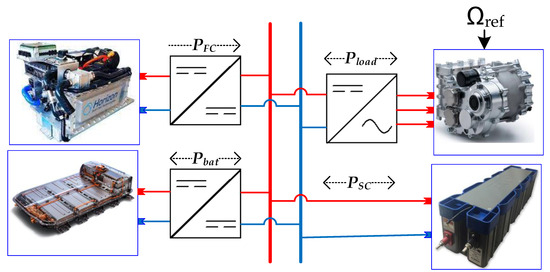
Figure 1.
Arrangement of the considered HPS system.
The fuel cell (FC) regulates explicitly and balances the load demand’s average net power. On the other hand, the batteries and supercapacitors are intended to provide additional load support during continuous operation and transient peak demand scenarios. These energy storage devices ensure that the load’s power requirements are met consistently, both during regular operation and during surges in power demand. The hybrid power system can efficiently handle variable load situations and optimize overall performance and efficiency by combining the capabilities of the FC and the energy storage devices. Lithium-ion batteries are utilized, with the nominal voltage and rated capacity set at 48 V and 40 Ah, respectively. The battery’s initial state of charge is 65%, and its response time is 20 s; for the supercapacitor, the rated capacitance and voltage are 15.6 F and 291.6 V, respectively, with an initial voltage and operating temperature of 270 V and 25 C. The FC in use is a 12.5 kW PEMFC comprising 65 series-connected cells. Its nominal stack efficiency and operating temperature are 50% and 45 °C, respectively. The voltage in the DC link is regulated by the battery converters, which contain a simple PI controller.
One significant difference between energy management systems (EMS) is the method used to calculate the PEMFC reference power. A 12.5 kW PEMFC boost converter is used in this particular installation. This boost converter regulates the output voltage and limits the input current. Two DC/DC converters are used to simplify the integration and operation of the hybrid power system. The first is a 4 kW boost converter in charge of emptying the battery system, while the second is a 1.2 kW buck converter that charges the battery system. These converters also feature regulated output voltages and current restrictions. In addition, the total system includes a 15 kVA, 270 V DC to 200 V AC, 400 Hz inverter system. This inverter system converts DC electricity to alternating current at the appropriate voltage and frequency. These components, which include the PEMFC boost converter, DC/DC converters, and the inverter system, collectively contribute to the hybrid system’s efficient operation and power management, ensuring optimal utilization of the various power sources and meeting the application’s specific power demands. Average traction forces (Ftr) can be estimated as a function of physical forces exerted on the vehicle body [36] and presented as
where Fm is the generated force by the motor, Far is the aerodynamic force, FR is the force of the rolling resistance, and FU is the uphill driving force (in the case of an inclined road).
2.1. PEMFC
FC turns hydrogen and oxygen into electricity through an electrochemical reaction, with a proton exchange membrane acting as the electrolyte [37]. The perfluoro sulfonic acid polymer Nafion is frequently used to make the thin, solid polymer electrolyte membrane in PEMFCs [38,39]. While serving as a barrier for electrons and preventing the mixing of reactant gases, this membrane selectively permits the flow of protons (H+). The high power density, quick startup times, and low operating temperatures of PEMFCs are only a few benefits. They are widely utilized in many applications, such as stationary power generation, portable power systems, and transportation (fuel cell cars). Research and development efforts are still concentrated on PEMFC technology to increase effectiveness, longevity, and affordability for widespread deployment. One of the most often used forms of FC in practical applications is PEMFC, which is used for both stationary and mobile applications as well as transportation applications. For explaining the nonlinearity of the FC, one of the most used PEMFC models is expressed as a function of the Nernst voltage (uNernset), activation voltage (vact), concentration voltage (vcon), and ohmic losses (vohm).
2.2. Supercapacitor
A supercapacitor, often called an ultracapacitor or an electrochemical capacitor, is a form of energy storage between conventional capacitors and batteries. Unlike chemical reactions, it uses the electrostatic charge principle to store and release electrical energy, allowing quick energy storage and discharge cycles. Utilizing electrostatic charge separation, supercapacitors store electrical energy. They comprise two electrodes, usually two pieces of activated carbon or other porous materials with large surface areas, submerged in an electrolyte solution. At the electrode–electrolyte interfaces, electrical charges build up when a voltage is applied, resulting in a double-layer capacitance. The energy density, overall energy storage capacity, and cost-effectiveness of supercapacitors are still active areas of study and development. They offer special advantages for uses that need high power, quick charge/discharge cycles, and long cycle life.
The authors in [40], state that the equivalent series resistance RS, which stands in for charging/discharging resistance, the capacitance Ccell, which stands in for the SC capacity, and the equivalent parallel resistance RR, which stands in for self-discharge losses, constitute the model of the SC.
2.3. Lithium-Ion Battery
There are various electrochemical models for lithium-ion batteries, including the internal resistance battery model, the single RC network battery model (Thevenin model), and the Randles circuit [41]. The Shepherd model [42], is one of the most commonly used models for expressing the electrical aspect. The open circuit voltage (uoc), polarization voltage losses (vpol), exponential voltage losses (vexp), and ohmic losses (vohm) can all be used to calculate the battery discharging voltage.
2.4. Converters
Both the battery and the SC are coupled to the DC bus in the hybrid power system under discussion via bidirectional DC/DC boost converters. This configuration allows power to flow in either way, allowing the energy storage systems (ESS) to be charged or discharged. Multilevel converters can be used to reduce current fluctuations and improve power quality on the DC bus. These converters contribute to lower ripple and a more consistent power supply to the DC bus. In the case of the fuel cell (FC) case, a multilayer boost converter transfers the power generated by the FC to the DC bus while maintaining low current variations. The multilevel converter architecture is required to safeguard the FC stack from the potentially detrimental effects of current fluctuations, which could shorten its lifespan. The vehicle motor, on the other hand, is powered by a bidirectional DC/AC converter. This converter allows power to flow in both directions, transferring energy from the DC bus to the motor during propulsion and back to the DC bus during regenerative braking. This bidirectional capacity provides efficient energy utilization and braking energy recovery, adding to overall system efficiency. Power flow in the hybrid power system may be successfully managed, current fluctuations can be avoided, and energy can be efficiently utilized throughout the system by using bidirectional converters and multilevel converter structures.
3. Energy Management Strategies
The design of EMSs has aroused the energy research community’s curiosity. According to [27], this interest originates from the ongoing and expanding development of renewable and hybrid power systems and the optimization of EMS technology using sophisticated energy storage devices [43].
3.1. PI
The deviation of the battery SoC and the targeted one is sent into the PI, and the PI output is the power of the battery, which is then deducted from the traction system power to yield the FC reference power [44]. When the battery’s SoC is more than the reference, the power of the FC is reduced, and the battery delivers its maximum power. When the battery’s SoC is lower than the reference, the FC supplies almost all of the motor power. This system is easier than other methods, and the PI improvements are modified in real-time for a better response.
3.2. ECMS
The ECMS attempts to minimize consumption of hydrogen and maintain the battery SoC within permitted levels.
The main target of the ECMS is maximizing the power supplied by the bus capacitor and the battery:
where ΔT is time of sampling, v is the voltage at charge/discharge, Pbat represents the battery power given at ΔT, and Cbus represents the supercapacitor capacitance associated with the DC bus. This function has an inequality constraint based on the battery’s energy, which depends on its SoC. It can be expressed as follows
where the SoCmin is the minimum battery SoC level, and Vbat and Qbat are the battery nominal voltage and capacity.
The DC bus voltage and the battery power should be limited to protect the battery and enhance the power quality. These limitations are expressed as follows:
where and are the DC bus voltage’s lower and upper limits.
3.3. Optimized ECMS-Based HHO
HHO is a metaheuristic optimization algorithm inspired by the collective behavior and pursuit strategy of Harris Hawks [35]. Multiple hawks collaborate to pounce on prey from various directions in an attempt to catch it off guard. Harris hawks can pursue in multiple ways depending on the dynamic nature of events and the prey’s evasive moves. The HHO simulates these actions mathematically. Figure 2 depicts the major steps of the algorithm.
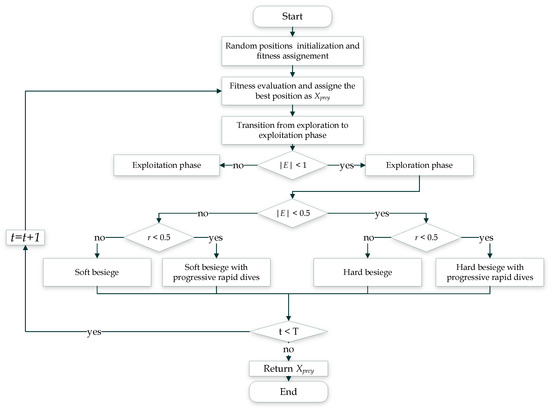
Figure 2.
Arrangement of HHO.
The proposed method in this study uses HHO to minimize the ECMS objective function mentioned in Equation (2). The optimization variables are battery power and charge/discharge voltage, including their constraints in Equations (3) and (4), representing the limited search space.
4. Results and Discussion
The fuel cell (FC) balances the average net power requested by the load in the stated hybrid power system. On the other hand, the batteries and supercapacitors are intended to assist during continuous operation and peak demand periods. The system models are constructed in Matlab/Simulink platforms. These models are created based on the models of each subsystem including the source models, the DC bus, and the tractions system equations as described in Section 2. The system parameters used in the simulation tests are presented in Table 2.

Table 2.
System parameters.
The voltage and current of the FC are not explicitly stated in the material provided. Battery converters are used to adjust the voltage in the DC link, and they include a simple Proportional-Integral (PI) controller. The PI controller aids in the maintenance of the desired voltage level in the DC link. The method used to obtain the reference power for the PEMFC is one key distinction between the various energy management systems (EMS). A PEMFC boost converter is used in this particular installation. This boost converter regulates the output voltage and limits the input current. In addition, two DC/DC converters are used, one to discharge the battery system (boost converter) and one to charge the battery system (buck converter). These converters also have the ability to limit current and maintain regulated output voltages. The system also includes an inverter system that converts DC electricity to AC power while meeting the voltage and frequency requirements. The Federal Test Procedure (FTP-75), which replicates the city driving cycle, was used in the study. Figure 3 (not given) depicts the speed profile and traction power required by the motor during this drive cycle. The FTP-75 cycle consists of three phases: the transient cold-start phase (0–505 s), the stable phase (506–1372 s), and the transient hot-start phase (1373–2000 s). At the end of the stabilization phase, the vehicle is turned off during the hot-start phase. Therefore, for this reason, this phase is ignored. In this study, the first 120 s of this profile are included.
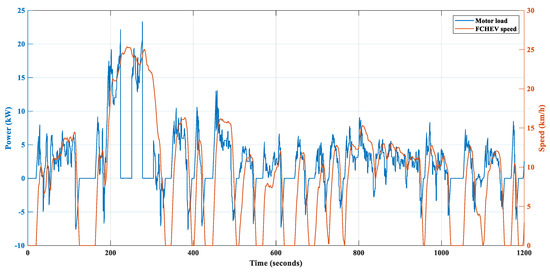
Figure 3.
Speed and traction power profiles.
The simulations started with the same initial conditions for the battery and SC (battery SoC of 70%, supercapacitor voltage of 270 V). The hydrogen consumption in liters per minute and grams are presented in Figure 4 and Figure 5, respectively. From these curves, the proposed strategy (in the blue line) has the ability to reduce hydrogen consumption and the consumption rate compared to the other considered strategies.
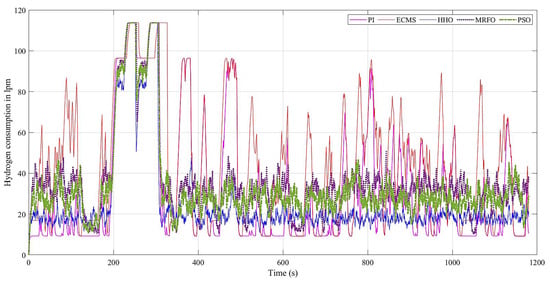
Figure 4.
Hydrogen consumption in liters per minute (lpm).
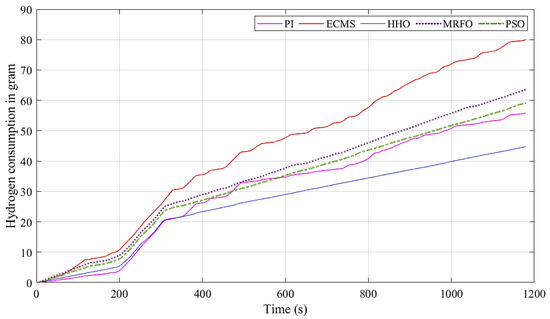
Figure 5.
Hydrogen consumption in grams.
Table 3 demonstrates the comparison results between the different considered ESMs. The comparison revealed the superiority of ECMS-based HHO. The ECMS-based HHO decreases the consumed hydrogen from 80.03 g (using the original ECMS) to 44.78 g.

Table 3.
Comparison between different considered EMSs.
In summary, the implementation of ECMS-based HHO showed significant improvements compared to other control strategies, namely PI, ECMS, MRFO, and PSO. First, the ECMS-based HHO system showed significant reductions in hydrogen consumption. It decreased by 19.81% compared to the traditional PI strategy, 44.05% compared to ECMS, 24.23% compared to MRFO, and 29.6% compared to PSO. This significant reduction in hydrogen consumption indicates the effectiveness of the proposed ECMS-based approach in reducing hydrogen consumption and resource management. Moreover, the system’s efficiency is considerably improved by using the ECMS-based HHO strategy. It recorded an efficiency improvement of 0.09% over the PI control strategy, 12.07% over the ECMS, 13.02% over the MRFO, and 16.68% over the PSO. These efficiency gains prove the superiority of the ECMS-based HHO approach in achieving more economical and environmentally friendly hydrogen-powered systems. However, it is necessary to consider a trade-off with the battery’s state of charge (SoC) when using the ECMS-based HHO method. This resulted in a reduction in SoC of 3.79% compared to the PI strategy, 13.42% compared to the ECMS, 7.5% compared to the MRFO, and 9.64% compared to the PSO strategy. This SoC reduction could be an essential issue to investigate, as it could affect the overall performance and stability of a hydrogen-based system over extended use. The ECMS-based HHO approach showed significant progress when assessing the overall performance index. It improved by 16.11% compared to the PI strategy, 42.7% to the ECMS, 29.75% to MRFO, and 36.65% to PSO.
As illustrated in Figure 6, the fuel cell (FC) covers most of the load with slower dynamics while the battery acts as an energy reservoir, storing excess energy to ensure a stable power supply. FC may take time to reach its desired output. The energy stored in the battery can be discharged during periods of high demand or FC power shortage, which enhances system reliability. However, the fast variations in the load are addressed by the supercapacitor (SC), which is capable of storing and rapidly releasing electrical energy.
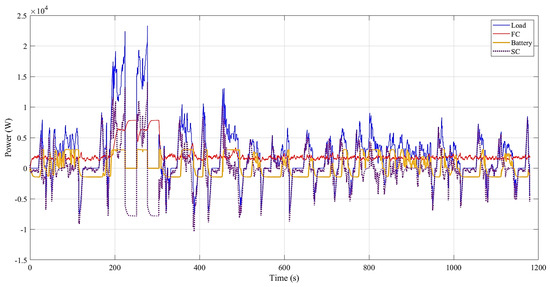
Figure 6.
Dynamic response of the generated power by different components in the DC microgrid using BWO.
Figure 7 depicts the SC voltage. The variations in the voltage can be explained by the variations of the absorbed or released power in the DC bus. Its voltage value is 270 V when power generation and demand are balanced. However, SC voltage is quickly discharged during sudden load fluctuations to meet the instantaneous power requirements.
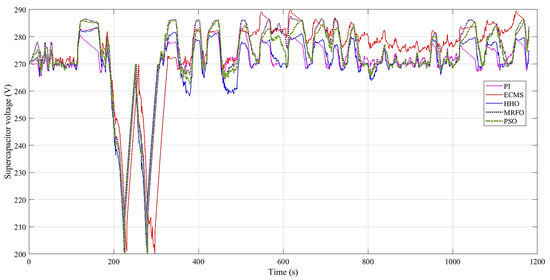
Figure 7.
The supercapacitor voltage under different EMSs.
Figure 8 presents the FC voltage results obtained from different control strategies. The proposed strategy utilizes the FC with moderate dynamics compared to other approaches. This choice leads to an extended state of health for the fuel cell, promoting durability, efficiency, and cost-effectiveness.
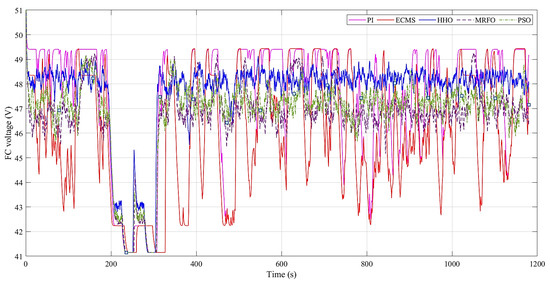
Figure 8.
The FC voltage under different EMSs.
The battery voltage is illustrated in Figure 9. The battery voltage using the proposed strategy based on the HHO, includes high voltage fluctuations. This can be explained by the fact that the battery system should protect the FC system and reduce its voltage fluctuations. This increases its voltage fluctuations as shown in this figure.
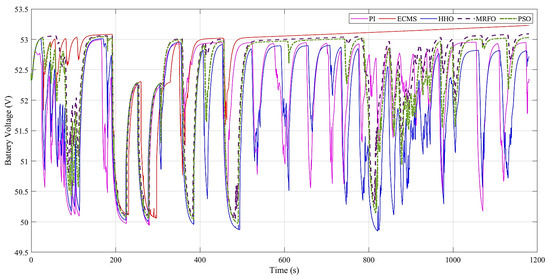
Figure 9.
The battery voltage under different EMSs.
5. Conclusions
This paper presents a new energy management strategy for a hybrid fuel cell electric vehicle. The practical contribution of this research lies in introducing an energy management system based on an optimized version of the EEMS through the application of the Harris Hawks Optimizer (HHO). This novel approach aims to enhance the efficiency, fuel saving, and overall performance of hybrid power systems applied to FCEVs. The main goals of this study can be listed as follows:
- -
- To create an optimal EMS for FCEV to realize the best power distribution, minimize fuel consumption, and increase electrical efficiency.
- -
- To improve the External Energy Maximization Strategy (EEMS), the suggested EMS incorporates the Harris Hawks Optimizer (HHO).
- -
- A comparison simulation for the city driving cycle was performed to assess the proposed EMS using the Federal Test Procedure (FTP-75).
The proposed EMS was tested against classical PI control, ECMS “Equivalent Consumption Minimization Strategy”, Particle Swarm Optimization (PSO), and Manta Ray Foraging Optimization (MRFO). The efficiency of the electrical systems and fuel consumption were evaluated. The results showed that the proposed EMS reduced fuel usage by 19.81% when compared to the other methods (PI, ECMS, MRFO, and PSO). Furthermore, overall efficiency increased by 0.09%. This research intends to address the goals of reducing fuel consumption and improving the efficiency of the power system. Given the complexity of the battery State of Charge (SoC), the authors intend to investigate the multi-optimization challenge in future work. Furthermore, evaluating power losses will be critical in optimizing system performance.
The proposed strategy’s main limitation is its real-time application implementation. The optimizer needs a very fast calculator to reduce the objective function better. However, with the development in processing technology, this problem can be solved in the near future.
Author Contributions
Conceptualization, H.R., M.A.A. and E.T.S.; Methodology, H.R., E.T.S. and M.R.; Software, H.R. and S.I.A.; Validation, S.I.A.; Formal analysis, M.A.A., S.I.A., E.T.S. and M.R.; Investigation, M.R. and A.G.O.; Resources, A.G.O.; Writing—original draft, H.R., M.A.A., S.I.A., E.T.S., M.R. and A.G.O.; Writing—review & editing, H.R., M.A.A., S.I.A., E.T.S., M.R. and A.G.O.; Supervision, S.I.A. and A.G.O. All authors have read and agreed to the published version of the manuscript.
Funding
This research was funded by Princess Nourah bint Abdulrahman University Researchers Supporting Project number (PNURSP2023R197), Princess Nourah bint Abdulrahman University, Riyadh, Saudi Arabia.
Institutional Review Board Statement
Not applicable.
Informed Consent Statement
Not applicable.
Data Availability Statement
Not applicable.
Acknowledgments
Princess Nourah bint Abdulrahman University Researchers Supporting Project number (PNURSP2023R197), Princess Nourah bint Abdulrahman University, Riyadh, Saudi Arabia.
Conflicts of Interest
The authors declare no conflict of interest.
References
- York, R.; Bell, S.E. Energy transitions or additions?: Why a transition from fossil fuels requires more than the growth of renewable energy. Energy Res. Soc. Sci. 2019, 51, 40–43. [Google Scholar] [CrossRef]
- Liu, J.; Dumitrescu, C.E. Flame development analysis in a diesel optical engine converted to spark ignition natural gas operation. Appl. Energy 2018, 230, 1205–1217. [Google Scholar] [CrossRef]
- Liu, J.; Dumitrescu, C.E. 3D CFD simulation of a CI engine converted to SI natural gas operation using the G-equation. Fuel 2018, 232, 833–844. [Google Scholar] [CrossRef]
- Yang, R.; Yan, Y.; Liu, Z.; Liu, J. Formation and Evolution of Thermal and Fuel Nitrogen Oxides in the Turbulent Combustion Field of Ammonia Internal Combustion Engines; SAE International: Washington, DC, USA, 2023. [Google Scholar] [CrossRef]
- Yan, Y.; Yang, R.; Liu, Z.; Liu, J. Nitrogen Oxides Emission Characteristics of Zero-Carbon Ammonia-Hydrogen Fuels for Internal Combustion Engines; SAE International: Washington, DC, USA, 2023. [Google Scholar] [CrossRef]
- Olabi, A.C.; Abdelkareem, M.A.; Wilberforce, T.; Alami, A.H.; Alkhalidi, A.; Hassan, M.M.; Sayed, E.T. Strength, weakness, opportunities, and threats (SWOT) analysis of fuel cells in electric vehicles. Int. J. Hydrogen Energy 2023, 48, 23185–23211. [Google Scholar] [CrossRef]
- Olabi, A.G.; Abdelkareem, M.A.; Wilberforce, T.; Alkhalidi, A.; Salameh, T.; Abo-Khalil, A.G.; Mutasim Hassan, M.; Sayed, E.T. Battery electric vehicles: Progress, power electronic converters, strength (S), weakness (W), opportunity (O), and threats (T). Int. J. Thermofluids 2022, 16, 100212. [Google Scholar] [CrossRef]
- Musa, M.T.; Shaari, N.; Kamarudin, S.K.; Wong, W.Y. Recent biopolymers used for membrane fuel cells: Characterization analysis perspectives. Int. J. Energy Res. 2022, 46, 16178–16207. [Google Scholar] [CrossRef]
- Raduwan, N.F.; Shaari, N.; Kamarudin, S.K.; Masdar, M.S.; Yunus, R.M. An overview of nanomaterials in fuel cells: Synthesis method and application. Int. J. Hydrogen Energy 2022, 47, 18468–18495. [Google Scholar] [CrossRef]
- Zakaria, Z.; Kamarudin, S.K.; Wahid, K.A.A.; Abu Hassan, S.H. The progress of fuel cell for malaysian residential consumption: Energy status and prospects to introduction as a renewable power generation system. Renew. Sustain. Energy Rev. 2021, 144, 110984. [Google Scholar] [CrossRef]
- Aminudin, M.; Kamarudin, S.; Lim, B.; Majilan, E.; Masdar, M.; Shaari, N. An overview: Current progress on hydrogen fuel cell vehicles. Int. J. Hydrogen Energy 2023, 48, 4371–4388. [Google Scholar] [CrossRef]
- Abo-Khalil, A.G.; Abdelkareem, M.A.; Sayed, E.T.; Maghrabie, H.M.; Radwan, A.; Rezk, H.; Olabi, A. Electric vehicle impact on energy industry, policy, technical barriers, and power systems. Int. J. Thermofluids 2022, 13, 100134. [Google Scholar] [CrossRef]
- Changizian, S.; Ahmadi, P.; Raeesi, M.; Javani, N. Performance optimization of hybrid hydrogen fuel cell-electric vehicles in real driving cycles. Int. J. Hydrogen Energy 2020, 45, 35180–35197. [Google Scholar] [CrossRef]
- Veziroglu, A.; Macario, R. Fuel cell vehicles: State of the art with economic and environmental concerns. Int. J. Hydrogen Energy 2011, 36, 25–43. [Google Scholar] [CrossRef]
- Office USD of EFCT. Multi-Year Research D, and Deployment Plan (MYRDD Plan): Fuel Cells. 2016. Available online: https://www.energy.gov/sites/prod/files/2014/12/f19/fcto_myrdd_full_document.pdf (accessed on 1 May 2023).
- Sanguesa, J.A.; Torres-Sanz, V.; Garrido, P.; Martinez, F.J.; Marquez-Barja, J.M. A Review on Electric Vehicles: Technologies and Challenges. Smart Cities 2021, 4, 372–404. [Google Scholar] [CrossRef]
- Huang, Q.; Liu, J. Practical limitations of lane detection algorithm based on Hough transform in challenging scenarios. Int. J. Adv. Robot. Syst. 2021, 18, 17298814211008752. [Google Scholar] [CrossRef]
- Nazari-Heris, M.; Abapour, M.; Mohammadi-Ivatloo, B. An Updated Review and Outlook on Electric Vehicle Aggregators in Electric Energy Networks. Sustainability 2022, 14, 15747. [Google Scholar] [CrossRef]
- Wang, Z.; Luo, W.; Xu, S.; Yan, Y.; Huang, L.; Wang, J.; Hao, W.; Yang, Z. Electric Vehicle Lithium-Ion Battery Fault Diagnosis Based on Multi-Method Fusion of Big Data. Sustainability 2023, 15, 1120. [Google Scholar] [CrossRef]
- Li, T.; Liu, H.; Zhao, D.; Wang, L. Design and analysis of a fuel cell supercapacitor hybrid construction vehicle. Int. J. Hydrogen Energy 2016, 41, 12307–12319. [Google Scholar] [CrossRef]
- Li, C.-Y.; Liu, G.-P. Optimal fuzzy power control and management of fuel cell/battery hybrid vehicles. J. Power Source 2009, 192, 525–533. [Google Scholar] [CrossRef]
- Zhang, Z.; Guan, C.; Liu, Z. Real-Time Optimization Energy Management Strategy for Fuel Cell Hybrid Ships Considering Power Sources Degradation. IEEE Access 2020, 8, 87046–87059. [Google Scholar] [CrossRef]
- Nasri, S.; Sami, B.S.; Cherif, A. Power management strategy for hybrid autonomous power system using hydrogen storage. Int. J. Hydrogen Energy 2016, 41, 857–865. [Google Scholar] [CrossRef]
- Sulaiman, N.; Hannan, M.; Mohamed, A.; Majlan, E.; Daud, W.W. A review on energy management system for fuel cell hybrid electric vehicle: Issues and challenges. Renew. Sustain. Energy Rev. 2015, 52, 802–814. [Google Scholar] [CrossRef]
- Xue, Q.; Zhang, X.; Teng, T.; Zhang, J.; Feng, Z.; Lv, Q. A Comprehensive Review on Classification, Energy Management Strategy, and Control Algorithm for Hybrid Electric Vehicles. Energies 2020, 13, 5355. [Google Scholar] [CrossRef]
- Peng, H.; Li, J.; Löwenstein, L.; Hameyer, K. A scalable, causal, adaptive energy management strategy based on optimal control theory for a fuel cell hybrid railway vehicle. Appl. Energy 2020, 267, 114987. [Google Scholar] [CrossRef]
- Roozegar, M.; Angeles, J. The optimal gear-shifting for a multi-speed transmission system for electric vehicles. Mech. Mach. Theory 2017, 116, 1–13. [Google Scholar] [CrossRef]
- Zhang, X.; Ren, X.; Zheng, C.; Yuan, Y.; Diao, L. Dynamic Programming in Energy Management Strategy for Optimizing Multi-energy Drive System. In Proceedings of the 4th International Conference on Electrical and Information Technologies for Rail Transportation (EITRT) 2019: Novel Traction Drive Technologies of Rail Transportation; Springer: Singapore, 2019; pp. 471–480. [Google Scholar]
- Leroy, T.; Vidal-Naquet, F.; Tona, P. Stochastic Dynamic Programming based Energy Management of HEV’s: An Experimental Validation. IFAC Proc. Vol. 2014, 47, 4813–4818. [Google Scholar] [CrossRef]
- Lü, X.; Wu, Y.; Lian, J.; Zhang, Y.; Chen, C.; Wang, P.; Meng, L. Energy management of hybrid electric vehicles: A review of energy optimization of fuel cell hybrid power system based on genetic algorithm. Energy Convers. Manag. 2020, 205, 112474. [Google Scholar] [CrossRef]
- Ahmadi, S.; Bathaee, S.; Hosseinpour, A.H. Improving fuel economy and performance of a fuel-cell hybrid electric vehicle (fuel-cell, battery, and ultra-capacitor) using optimized energy management strategy. Energy Convers. Manag. 2018, 160, 74–84. [Google Scholar] [CrossRef]
- Antarasee, P.; Premrudeepreechacharn, S.; Siritaratiwat, A.; Khunkitti, S. Optimal Design of Electric Vehicle Fast-Charging Station’s Structure Using Metaheuristic Algorithms. Sustainability 2023, 15, 771. [Google Scholar] [CrossRef]
- Rezk, H.; Nassef, A.M.; Abdelkareem, M.A.; Alami, A.H.; Fathy, A. Comparison among various energy management strategies for reducing hydrogen consumption in a hybrid fuel cell/supercapacitor/battery system. Int. J. Hydrogen Energy 2021, 46, 6110–6126. [Google Scholar] [CrossRef]
- Zhao, J.; Ramadan, H.; Becherif, M. Metaheuristic-based energy management strategies for fuel cell emergency power unit in electrical aircraft. Int. J. Hydrogen Energy 2019, 44, 2390–2406. [Google Scholar] [CrossRef]
- Heidari, A.A.; Mirjalili, S.; Faris, H.; Aljarah, I.; Mafarja, M.; Chen, H. Harris hawks optimization: Algorithm and applications. Futur Gener. Comput. Syst. 2019, 97, 849–872. [Google Scholar] [CrossRef]
- Zhang, X.; Mi, C. Vehicle Power Management: Modeling, Control and Optimization; Springer Science & Business Media: London, UK, 2011. [Google Scholar]
- Shaari, N.; Kamarudin, S.K. Current status, opportunities, and challenges in fuel cell catalytic application of aerogels. Int. J. Energy Res. 2019, 43, 2447–2467. [Google Scholar] [CrossRef]
- Musa, M.T.; Shaari, N.; Kamarudin, S.K. Carbon nanotube, graphene oxide and montmorillonite as conductive fillers in polymer electrolyte membrane for fuel cell: An overview. Int. J. Energy Res. 2021, 45, 1309–1346. [Google Scholar] [CrossRef]
- Alnaqbi, H.; Sayed, E.T.; Al-Asheh, S.; Bahaa, A.; Alawadhi, H.; Abdelkareem, M.A. Current progression in graphene-based membranes for low temperature fuel cells. Int. J. Hydrogen Energy, 2022; in press. [Google Scholar] [CrossRef]
- Yoon, S.; Lee, C.W.; Oh, S.M. Characterization of equivalent series resistance of electric double-layer capacitor electrodes using transient analysis. J. Power Source 2010, 195, 4391–4399. [Google Scholar] [CrossRef]
- Fotouhi, A.; Auger, D.J.; Propp, K.; Longo, S.; Wild, M. A review on electric vehicle battery modelling: From Lithium-ion toward Lithium–Sulphur. Renew. Sustain. Energy Rev. 2016, 56, 1008–1021. [Google Scholar] [CrossRef]
- Shepherd, C.M. Design of primary and secondary cells: II. An equation describing battery discharge. J. Electrochem. Soc. 1965, 112, 657. [Google Scholar] [CrossRef]
- Vásquez, L.O.P.; Ramírez, V.M.; Thanapalan, K. A Comparison of Energy Management System for a DC Microgrid. Appl. Sci. 2020, 10, 1071. [Google Scholar] [CrossRef]
- Thounthong, P.; Rael, S. The benefits of hybridization. IEEE Ind. Electron. Mag. 2009, 3, 25–37. [Google Scholar] [CrossRef]
Disclaimer/Publisher’s Note: The statements, opinions and data contained in all publications are solely those of the individual author(s) and contributor(s) and not of MDPI and/or the editor(s). MDPI and/or the editor(s) disclaim responsibility for any injury to people or property resulting from any ideas, methods, instructions or products referred to in the content. |
© 2023 by the authors. Licensee MDPI, Basel, Switzerland. This article is an open access article distributed under the terms and conditions of the Creative Commons Attribution (CC BY) license (https://creativecommons.org/licenses/by/4.0/).